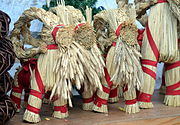
Yule is a winter festival historically observed by the Germanic peoples that was incorporated into Christmas during the Christianisation of the Germanic peoples. In present times adherents of some new religious movements celebrate Yule independently of the Christian festival. Scholars have connected the original celebrations of Yule to the Wild Hunt, the god Odin, and the heathen Anglo-Saxon Mōdraniht. The term Yule and cognates are still used in English and the Scandinavian languages as well as in Finnish and Estonian to describe Christmas and other festivals occurring during the winter holiday season. Furthermore, some present-day Christmas customs and traditions such as the Yule log, Yule goat, Yule boar, Yule singing, and others may have connections to older pagan Yule traditions.
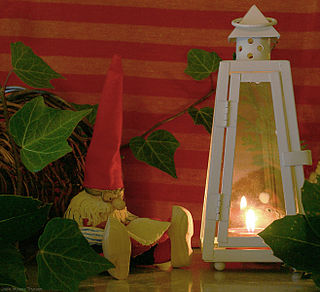
A nisse, tomte, tomtenisse, or tonttu is a mythological creature from Nordic folklore today typically associated with the winter solstice and the Christmas season. They are generally described as being short, having a long white beard, and wearing a conical or knit cap in gray, red or some other bright colour. They often have an appearance somewhat similar to that of a garden gnome.

Corn dollies or corn mothers are a form of straw work made as part of harvest customs of Europe before mechanisation.
Ziemassvētki, also Ziemsvētki is an annual festival in Latvia which observes the winter solstice and birth of Jesus Christ. Latvians around the world celebrate it from 24 to 25 December. 24 December is Ziemassvētku vakars, 24 December is Ziemassvētku vakars, while 25 December is Pirmie Ziemassvētki, 26 December Otrie Ziemassvētki. Christianity traditionally celebrates the birthday of Jesus Christ on 25 December, according to the Julian calendar, but Orthodox churches follow the Eastern Orthodox liturgical calendar and, as a result, the majority of Orthodox churches celebrate Ziemassvētki on 6, 7 and 8 January.
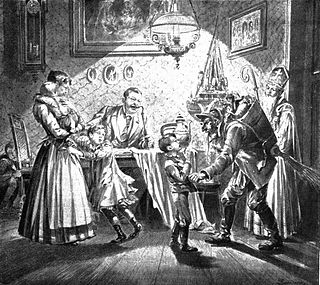
The companions of Saint Nicholas are a group of closely related figures who accompany Saint Nicholas throughout the territories formerly in the Holy Roman Empire or the countries that it influenced culturally. These characters act as a foil to the benevolent Christmas gift-bringer, threatening to thrash or abduct disobedient children. Jacob Grimm associated this character with the pre-Christian house spirit which could be benevolent or malicious, but whose mischievous side was emphasized after Christianization. The association of the Christmas gift-bringer with elves has parallels in English and Scandinavian folklore, and is ultimately and remotely connected to the Christmas elf in modern American folklore.
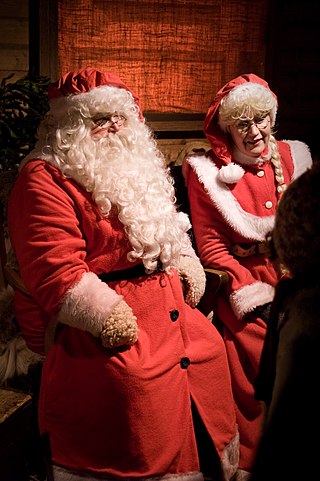
Joulupukki is a Finnish Christmas figure. The name joulupukki literally means 'Christmas goat' or 'Yule goat' in Finnish; the word pukki comes from the Germanic root bock, a cognate of English "buck", meaning 'billy-goat'. An old Nordic folk tradition, the figure is now often conflated with Santa Claus.

Ded Moroz, or Morozko, is a legendary figure similar to Saint Nicholas, Father Christmas, and Santa Claus who has his roots in Slavic mythology. The tradition of Ded Moroz is mostly spread in East Slavic countries and is a significant part of Russian culture. At the beginning of the Soviet era, communist authorities banned Ded Moroz. However, the ban was lifted and he soon became a significant part of Soviet culture. The literal translation of DedMoroz is Old Man Frost, but traditionally the name is translated as Father Frost.
Julemanden is the Christmas gift-bringer in modern Danish culture, the equivalent of Father Christmas or Santa Claus. Julemanden can be directly translated as "The Yule Man" or "The Christmas Man". Julemanden is often illustrated as a short, bearded man dressed in gray clothes and a red hat. He is said to bring presents on Christmas Eve, coming to houses either by foot or by sleigh, and often wears fur to keep him warm.

Jul or jol is the term used for the Christmas holiday season in Scandinavia and parts of Scotland. Originally, jul was the name of a month in the old Germanic calendar. The concept of jul as a period of time rather than a specific event prevailed in Scandinavia; in modern times, jul is a period of time stretching from the fourth Sunday before Christmas Eve, December 24, to (traditionally) mid-January at the date of Epiphany with the month of December and Christmas, and the week up to the New Year, as its highlight. The modern English yule and yuletide are cognates with this term.

The Christmas pickle is an American Christmas tradition. A decoration in the shape of a pickle is hidden on a Christmas tree, with the finder receiving either a reward or good fortune for the next year. There are a number of different origin stories attributed to the tradition, including one originating in Germany. This theory has since been discounted, and it is now thought to be a German-American tradition created in the late 19th century. In fact, the New York Times reported that out of 2,057 Germans polled, YouGov determined 91% were unaware of the legend.

The Gävle Goat is a traditional Christmas display erected annually at Slottstorget in central Gävle, Sweden. The display is a giant version of a traditional Swedish Yule goat figure made of straw. It is erected each year by local community groups at the beginning of Advent over a period of two days.

Julebukking is a Christmas tradition of Scandinavian origin.

Santa Claus is a legendary figure originating in Western Christian culture who is said to bring gifts during the late evening and overnight hours on Christmas Eve. He is said to accomplish this with the aid of Christmas elves, who make the toys in his workshop, and with the aid of flying reindeer who pull his sleigh through the air.

In English-speaking cultures, a Christmas elf is a diminutive elf that lives with Santa Claus at the North Pole and acts as his helper. Christmas elves are usually depicted as green- or red-clad, with large, pointy ears and wearing pointy hats. They are most often depicted as humanoids, but sometimes as furry mammals with tails. Santa's elves are often said to make the toys in Santa's workshop and take care of his reindeer, among other tasks.

A number of Midwinter or Christmas traditions in European folklore involve gift-bringers. Mostly involving the figure of a bearded old man, the traditions have mutually influenced one another, and have adopted aspects from Christian hagiography, even before the modern period. In Eastern Slavic countries, the figure is Father Frost. In Scandinavia, it is an elf-like figure or tomten who comes at Yule. In German-speaking Europe and Latin Europe, it became associated with the Christian Saint Nicholas. In some parts of Central Europe, there is a separate tradition of a young child or fairy-like being bringing presents, known as Christkind. Early modern England had Father Christmas, a character initially associated with feasting and good cheer, though he was not originally a gift bringer.

Christmas is celebrated throughout December and traditionally until St. Knut's Day on January 13. The main celebration and the exchange of gifts in many families takes place on Christmas Eve, December 24. The Feast of St. Lucy, a high point in the Swedish Christmas season, is celebrated during Advent, on December 13.
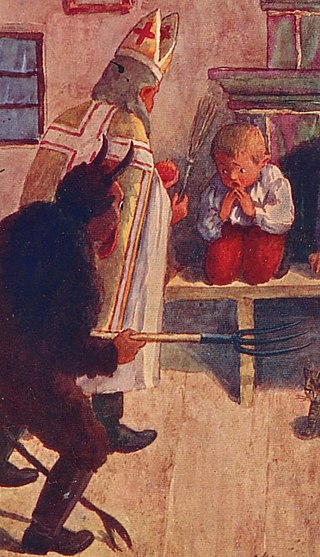
The Krampus is a horned anthropomorphic figure who, in the Central and Eastern Alpine folkloric tradition, is said to accompany Saint Nicholas on visits to children during the night of 5 December, immediately before the Feast of St. Nicholas on 6 December. In this tradition, Saint Nicholas rewards well-behaved children with small gifts, while Krampus punishes badly-behaved ones with birch rods.

Folklore of Finland refers to traditional and folk practices, technologies, beliefs, knowledge, attitudes and habits in Finland. Finnish folk tradition includes in a broad sense all Finnish traditional folk culture. Folklore is not new, commercial or foreign contemporary culture, or the so-called "high culture". In particular, rural traditions have been considered in Finland as folklore.
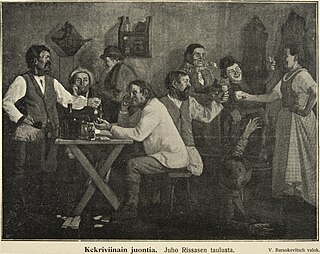
Kekri, also known as keyri, köyri, köyrykööri and kegri, is a Finnish and Karelian harvest festival, celebrated in the fall. Kekri was once widely celebrated in Finland and Karelia, but it has been largely eclipsed by Christmas, to which many old Kekri traditions have migrated. Historically, Kekri has also referred to a deity.

Christmas in Finland begins, as is commonplace on public holidays in Finland, on Christmas Eve. Especially the evening of Christmas Eve has become the most important day of the Christmas period, and is nowadays a paid holiday in most workplaces. Unlike on other public holidays, public transportation stops almost completely on the afternoon of Christmas Eve in Finland. The Christmas period ends on Epiphany.






